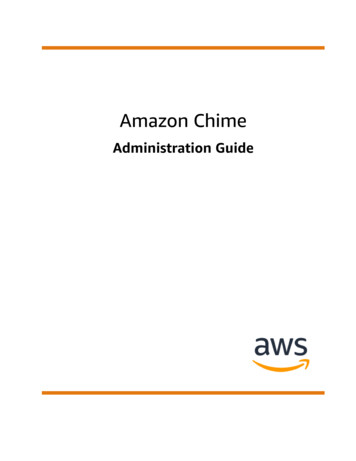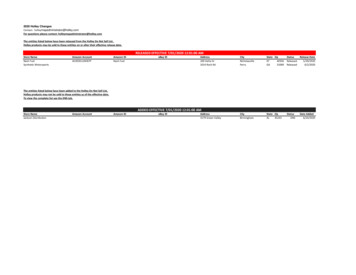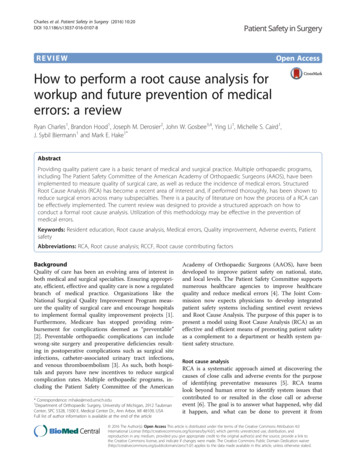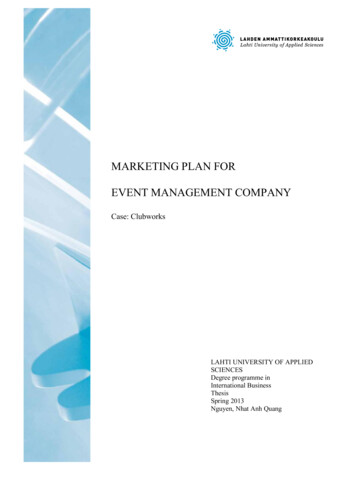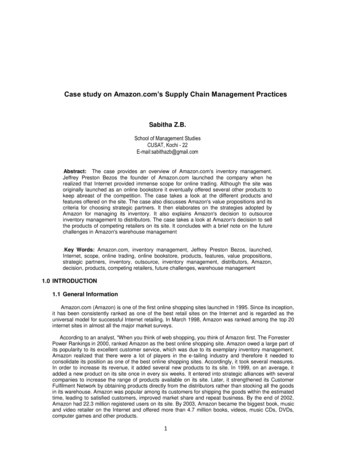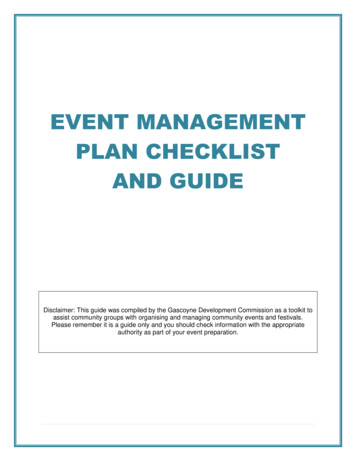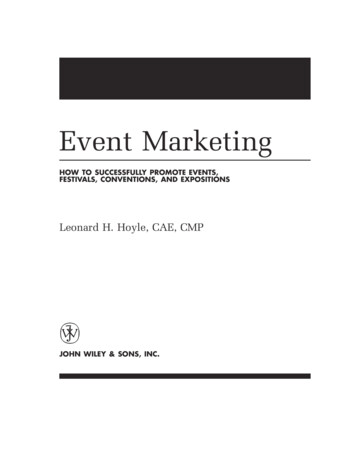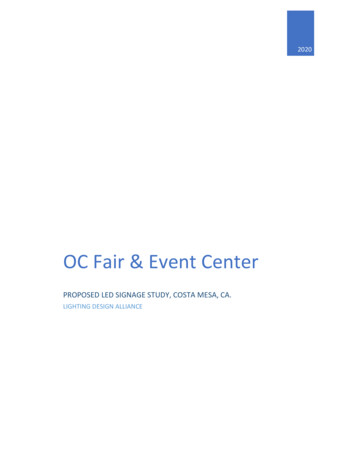
Transcription
2020OC Fair & Event CenterPROPOSED LED SIGNAGE STUDY, COSTA MESA, CA.LIGHTING DESIGN ALLIANCE
Table of Contents1 - EXECUTIVE SUMMARY . 22 - PROJECT DESCRIPTION. 23 – PROJECT ANALYSIS SCOPE. 134 – SITE SURVEY . 155 – SENSITIVE RECEPTORS (SR) . 216 – PROPOSED SIGNAGE IMPACTS TO SITE. 247 - MITIGATION MEASURES . 258 - CONCLUSION. 269 – GLOSSARY . 271
1 - EXECUTIVE SUMMARYIn coordination with Standard Vision (designer of the digital billboard system), Lighting Design Alliance(“LDA”), has conducted a study which evaluates the potential impacts of the proposed digitalbillboard/electronic display signs to the adjacent residential properties that are in proximity to the OC Fair& Event Center located in Costa Mesa, California. Potential impacts related to lighting would includeitems such as light trespass onto nearby properties, glare contributors, sensitivity zones, etc. The purposeof the lighting study is to examine the potential lighting impacts of the new digital signage within theadjacent residential neighborhoods.2 - PROJECT DESCRIPTIONThe OC Fair & Event Center is located between Fairview Road, Arlington Drive, Fair Drive and NewportBoulevard. The site is directly surrounded by commercial properties with a few residential propertieslocated across the South-West corner at Fairview Road. Across Fair Drive are commercial uses whichinclude an Arco gas station, Costa Mesa City Hall, Newport Mesa Church and several other businesses.Across Newport Boulevard is the Costa Mesa Freeway, a Best Western Plus, Santa Ana Country Cluband several other businesses. Across Arlington Drive is Costa Mesa High School, TeWinkle Park, DavisMagnet School and several other businesses. Few residential areas are adjacent to the site, located acrossFairview Road and between Fair Drive and Merrimac Way. Generally, the residential neighborhoodscontain single story buildings with a few buildings having two stories. A retaining wall surrounds thesebuildings facing the OC Fair site.The following map was produced by Continental Signs Inc. and shows the locations of the existing LEDsignage as well as the locations of the proposed new signage locations at 6 gate entrances.2
We have provided the same site map for reference, showing the commercial and residential zones in colorblockings. The red blocks designate commercial properties and the blue shows the residential properties.The green designates the proposed digital signage locations on the site.The OC Fair & Event Center is developed with multiple parking lots, open spaces and a largeamphitheater with access to the site via the public sidewalks and driveways throughout the property.Some of the uses existing within the development include exhibit spaces, shops, and general gatheringareas.3
We have included reference images of the overall site as it exists presently:-View from Fair Drive and Fairview Road intersection-View from Fairview Road and Princeton Drive intersection4
-View from Fairview Road and Merrimac Way intersection-View from Fairview Road and Arlington Drive intersection5
-View from Gate 4 at Arlington Drive-View from Gate 4-1/2 at Arlington Drive6
-View from Gate 5 at Arlington Drive-View from Gate 7 at Arlington Drive7
-View from Gate 8 at Arlington Drive-View from Gate 9 at Arlington Drive8
-View from Arlington Drive and Newport Boulevard intersection-View from Mesa Drive and Newport Boulevard9
-View from Newport Boulevard and Fair Drive-View at Gate 1 from Fair Drive10
-View from Fair Drive and Vanguard Way11
The project signage consists of existing LED displays as well as the proposed addition of new LEDsignage and backlit lettering. The proposed gate signage will consist of a standard structure which willstand 25'-0" above the ground with the LED message board being located 13'-0" above the ground. TheLED message board will be double-sided with dimensions of 7'-10.25" long by 3'-10.25" tall, and will beperpendicular to the site. These gate locations may be found on the site plan provided by ContinentalSigns Inc. Project signage may be stationary or convey changing messages and images.12
3 – PROJECT ANALYSIS SCOPEThe purpose of this lighting study is to examine the potential lighting impacts of the new LED digitalsignage at the identified locations within the adjacent residential neighborhoods. This analysis willdescribe the pedestrian survey performed to evaluate the existing conditions surrounding the project site,noting the locations, intensity, and directionality of light sources in the area as well as those sources’proximity to residential receptors.The City of Costa Mesa does not have an ordinance on brightness for signs. The City’s sign regulationssummary does state that electronic changeable copy signs, except theater marquees and time/temperaturesigns, are prohibited. The lighting analysis will discuss how the proposed LED digital signage will not/will not negatively impact the sensitive residential receptors. For reference, we have included otherportions of codes that are used for digital signage regulations, which includes a portion of a typical city’scode on digital signage, the California Environmental Quality Act (CEQA), and Title 24 limitations onsignage energy consumption. The analysis will then provide guidance, as needed, on ways to reducelighting and spillover lighting effects resulting from the Proposed Project.City of Los Angeles Municipal Code: Super Graphic Wall SignsSign Lighting. No super graphic wall sign shall be so illuminated that it interferes with the safety ofaircraft flights in the vicinity of the super graphic wall sign location. No super graphic wall sign shallemploy direct, indirect, internal, flashing, or other illumination with light sources or reflectivity such thatthe brightness of the illumination shall constitute a hazard to air traffic or a nuisance, interferes with thesafety of motorized vehicles in the vicinity of the super graphic wall sign location, confuses or obstructsthe view of any authorized traffic sign or signal, obstructs the sight distance triangle at any street orfreeway intersection, extends into the public right-of-way, or interferes with the use and enjoyment ofproperty of any adjacent property owners.California Environmental Quality Act (CEQA)CEQA, or the California Environmental Quality Act, is a statute that requires state and local agencies toidentify the significant environmental impacts of their actions and to avoid or mitigate those impacts, iffeasible.The following guidelines are being taken from the City of Los Angeles CEQA Thresholds Guide – 2006.These guidelines are not part of the City of Costa Mesa’s detailed lighting requirements and guidelines,but more used as recommended best practices for implementing lighting that will be less intrusive to theresidential areas that are in proximity to the area site.A.4. NIGHTTIME ILLUMINATIONThis section involves the extent to which a proposed project's artificial lighting affects the visualenvironment. Nighttime illumination of varying intensities is characteristic of most urban andsuburban land uses, including those in the City of Los Angeles. Artificial lighting has become morewidely utilized in recent years to address security concerns and aesthetics.13
New light sources introduced by a project may increase ambient nighttime illumination levels.Additionally, nighttime spillover of light onto adjacent properties has the potential to interfere withcertain functions, including vision, sleep, privacy, and general enjoyment of the natural nighttimecondition. The significance of the impact depends on the type of use affected, proximity to theaffected use, the intensity of the light source, and the existing ambient light environment. Usesconsidered sensitive to nighttime light include, but are not limited to, residential uses, some commercialand institutional uses, and natural areas.A review of surrounding land use was completed to determine the location of light-sensitive land uses.Light-sensitive land uses may include, but are not limited to, residences, including board and carefacilities; commercial or institutional uses that require minimal nighttime illumination for proper function,physical comfort, or commerce; and natural areas. The potential for routine spillover of light or anincrease in ambient light levels is determined by considering the project’s proximity to light-sensitiveuses, the intensity of project light sources, and the existing ambient light environment.CEQA mitigation measures that involve lighting include the following:Provides that no person shall construct, establish, create, or maintain any stationary exterior lightsource that may cause the following locations to either be illuminated by more than 2 footcandles(fc) of lighting intensity or receive direct glare from the light source:1) Any exterior glazed window or sliding glass door on any other property containing aresidential unit or units.2) Any elevated habitable porch, deck, or balcony on any other property containing a residentialunit or units.3) Any ground surface intended for uses such as recreation, barbecue, or lawn areas on any otherproperty containing a residential unit or units.Brightness and glare are dependent on the brightness of the surrounding environment. The project islocated in a dense urban environment, with a high ambient electric light level.Title 24 RegulationsTitle 24 regulates the wattage that any internally illuminated sign can produce. Section 148 of Title 242008 requires that all exterior LED signs have an efficiency of 80% or greater and have a maximumallowed lighting power of less than 12 watts per square foot.Title 24 limits energy use for exterior signage in California. Title-24 2008 limits exterior, internallyilluminated signs, and integral electronic displays to 12 watts/sq. ft.14
Title 24 Wattage limits affecting exterior internally illuminated signs nod integral electronic displaysWatt/sq. ftBrightness at Full WhiteHours onTotal watt-hours perat full white(candelas/sq. meters)per dayday per sq. ft. of signDaytime Usage123500*12144(7am to 7pm)Nighttime Usage51500*735(7pm to 2am)Total watt-hours per179day per sq. ft. of sign*Title 24 only restricts energy usage and does not restrict brightness4 – SITE SURVEYAs the Project Site is located within an existing commercial complex within the City of Costa Mesa, thismeans that there are existing brightness and glare contributors that exist both within the OC Fair & EventCenter site as well as throughout the commercial district surrounding it. LDA has performed an onsitenighttime survey of the OC Fair & Event Center site, adjacent commercial properties, and adjacentresidential neighborhoods. The purpose of these surveys was to identify the following:-Document existing footcandle or light levels to determine the existing threshold of brightness at keycommercial and residential points that we had access to. These light levels include all existing lightcontributors at each location at the time of the survey. This information was gathered to determine theexisting lighting levels around the site, and to make assumptions regarding how much light the LEDdigital signage would contribute to the sensitive receptor areas.-Document existing brightness contributors around the OC Fair & Event Center site, and the adjacentneighborhoods and their relationship to the adjacent neighborhoods if they are visible or not from theproperties. These can include existing illuminated signage, existing street or parking lot lighting poles,building mounted floodlights, etc.-Document each residential location that has a potential view of the proposed LED digital signage locatedaround the OC Fair & Event Center site.LDA conducted a series of site visits during the week of March 3, 2020 to the City of Costa Mesa for thepurposes of gathering existing light levels around the commercial and residential sites, and to collectcomparative brightness data from other comparable buildings and existing signage.This survey will give a good measurement of the existing light levels on the site and will make it easier toquantify the assumed added lighting to the overall site from the contribution of the digital signage.-Document existing footcandle or light levels:The first part of the survey involved getting the footcandle (FC) levels all around the public site to showexisting light levels. The footcandle is the amount of light that actually falls on a given surface. Theexisting site is currently affected by LED street poles, building mounted floodlights, and illuminatedsignage. All of these factors, and others, are currently contributing to the existing light levels on the site.15
In order to measure diversity, brightness, and density, measurements were taken during the day and againduring the evening. All footcandle/illuminance readings were taken using an illuminance/light meterfrom Konica Minolta – Chroma Meter CL-200A. For all footcandle readings taken in the study, all weretaken at 38” above the ground level in a horizontal orientation, with the illuminance meter beingstabilized on a tripod for consistent readings.For the footcandle survey, we have included an appendix document that contains a series of detailed mapswith accompanying reference images taken onsite where we show the footcandle measurements taken ateach significant location on site. Refer to the attached appendix for references for both commercial andresidential sites.-Document existing brightness contributorsThe second part of the survey involved taking note of existing brightness contributors that were locatedaround this project site. This involved taking luminance measurements (cd/m2) of the brightnesscontributors. Luminance is a photometric measurement of the luminous intensity of a surface and isdetermined by measuring the amount of light coming off a surface with a given area. The luminanceindicates how much luminous power will be detected by an eye looking at the surface from a particularviewing angle. This is an indicator of how bright the surface will appear, and if it will be a contributor toglare. Generally, if two objects were emitting the same amount of light, the smaller object will appearbrighter than the larger object may therefor contribute to glare.All luminance/brightness readings were taken using a luminance/spot meter from Minolta – LuminanceMeter LS-110, which measures in cd/m².16
All measurements were taken from ground level which is the viewpoint of the pedestrian and automobiletraffic. Note that the measurements were taken using a specific date and time and used a specificluminance meter. A different luminance meter may have a margin of error of /- 5% difference and asimages on static and digital signage are updated. Those different images produce different readings.While distance does not affect brightness, the viewing angle and the specific target can impact reading, soreadings may vary.SITE BRIGHTNESS DOCUMENTATION AND RESULTS:As the OC Fair & Event Center site is an existing property, it has existing architectural and signagelighting that is existing currently that is visible by the adjacent residential neighborhoods. The residentsof these areas have lived with the lighting from the OC Fair & Event Center site for years, and theexisting lighting has not caused issues such that the lighting need be toned down or modified. In additionto the OC Fair & Event Center site, there are also other commercial properties and city owned andoperated street lighting that are visible to the adjacent residential neighborhoods.As the main concern of this project are the proposed LED digital signs at the entry gates, we will focus onthe existing site lighting and signage, as well as their current brightness as a reference.- The series of high-pressure sodium illuminated pedestrian level poles around the sidewalk have abrightness level of 1,750 cd/m²17
-The series of six flood lights for the parking lot have a brightness level of 19,000 cd/m²-The existing high-pressure sodium pedestrian poles have a brightness level of 30,000 cd/m²18
-The existing LED signage at the box office has a brightness of 1,134 cd/m²-The existing LED signage at the entrance has a brightness of 184 and 234 cd/m²19
-The existing LED signage at entrance Gate 1 has a brightness of 1,827 cd/m²20
5 – SENSITIVE RECEPTORS (SR)In the following site map, we have indicated in BLUE, the existing residential properties that surround theproject site that we noted have a potential direct view of a portion of the LED digital signage at the OCFair & Event Center site. Residential properties represent sensitive receptors for the purpose of thisanalysis.To survey the potential impacts to the residential sites, we have detailed the more significant impactedresidential sites that have partial views of the proposed LED digital signage. We have broken them outindividually to discuss the potential impacts that the Project site may have and analyzed what thecontributed light levels will be per the photometric study.For determining the lighting impacts from the OC Fair & Event Center onto the Sensitive Receptors, wewill be using the City of Los Angeles’ CEQA thresholds for contributed light onto a residential site:Chapter IX, Article 3, Section 93.0117 of the City of Los Angeles Municipal Code (LAMC) provides thatno person shall construct, establish, create, or maintain any stationary exterior light source that may causethe following locations to either be illuminated by more than two footcandles of lighting intensity orreceive direct glare from the light source:1) Any exterior glazed window or sliding glass door on any other property containing a residential unit orunits.2) Any elevated habitable porch, deck, or balcony on any other property containing a residential unit orunits.3) Any ground surface intended for uses such as recreation, barbecue, or lawn areas on any other propertycontaining a residential unit or units.21
Sensitive Receptors 1 and 2:2329 Perdue DriveThese residences are two story properties that have a potential view of the proposed LED digital signage.From the ground level, the digital signage locations would not be visible due to the retaining wall thesurrounds the buildings. As there is a second floor to the property that we did not have access to, wewould assume that from the upper level, there would be slightly more of the signage visible from thatlevel, but not a significant amount considering the distance the property is away from the project site.The residence is located roughly 200 feet away from the existing signage location.Per the City of Los Angeles Municipal Code per CEQA, no lighting can provide more than 2.0footcandles at any part of a residence. As this residence is surrounded by a wall and the signage isexisting, the contributed lighting level at this Sensitive Receptor are going to be at such a low level that itwould be difficult to perceive the difference in lighting levels.22
Sensitive Receptor 3:201 Princeton DriveThis residence is a single-story property that has a view of a portion of the proposed LED digital signage.From the ground level, only the very top and portion of the center of the digital signage was visible. Theview and effect that the proposed signage would have on the property would not be a significant amountconsidering the distance the property is away from the project site.The residence is located roughly 775 feet away from the proposed signage location.Per the City of Los Angeles Municipal Code per CEQA, no lighting can provide more than 2.0footcandles at any part of a residence. As this residence is surrounded by a wall and the signage isexisting, the contributed lighting level at this Sensitive Receptor are going to be at such a low level that itwould be difficult to perceive the difference in lighting levels.23
6 – PROPOSED SIGNAGE IMPACTS TO SITETo understand the impact of the proposed signage, we must first look at the operational criteria that theclient is proposing to the site. This includes the brightness levels that the digital signage will be setduring daylight hours and during nighttime hours, hours of operation, and the dimming transition fromday to night and night to day.The client has provided a design guide for the LED digital signage for the site:-Sign luminance shall change during each day on the following schedule:-Daytime: From sunrise until 20 minutes prior to sunset, luminance shall not exceed 7,000 cd/m²brightness.*Note that in the code portion of the report, the recommended maximum brightness of the LEDsign during the day was 7,500 cd/m². We recommend the client set the maximum brightness at alower level than standard recommendations to accommodate potential brightness concerns.*We are recommending a 45-minute soft fade rate such that dimming is not noticeable by the eye.-Evening: From sunset until 20 minutes prior to sunrise Luminance shall not exceed 300 cd/m² -After Hours: From 2:00 am until sunrise, no animated content or moving patterns shall bepermitted.*Note that in the code portion of the report, the recommended maximum brightness of the LEDsign during the night was 1,500 cd/m². We recommend the client set the maximum brightness at300 cd/m², a lower level than standard recommendations to accommodate potential brightnessconcerns. The proposed LED digital signage will not be brighter than any light sources currentlyinstalled.-Illuminance from signs or architectural lights shall not exceed 1.4 footcandles at any adjacent residentialzoned property line.* Note that in the code portion of the report, the CEQA requirement for maximum contributed light is nomore than 2.0 footcandles on any adjacent property. The client is setting the maximum at 1.4 footcandlesso that there is a tougher standard that the digital signage must comply with above and beyond therecommended practices. For the concerns of light level contribution to the residential properties, therewill not be a large increase of lighting from the digital signage because there are already existingcontributors of light that are brighter sources than what is being proposed.For general signage operations: Integral electronic display signs are typically measured in nits, orcandelas per square meter. Typically, integral electronic display signs are made up of different coloredpixel diodes. A typical pixel consists of a red LED diode, a green LED diode, and a blue LED diode.The higher resolution an integral electronic display sign is, the more pixels it contains.White images on an integral electronic display are always the brightest, because the red, green and bluediodes are at full intensity. Because signs are rarely full white, the actual brightness of a sign is typicallymuch less than the suggested maximum luminance.For example, a typical integral electronic display has the 100% luminance settings for different colors:White: 7,000 candelas/m2Red: 1,500 candelas/m2Green: 5,100 candelas/m2Blue: 700 candelas/m224
The above values come from a report belonging to the Outdoor Advertising Association of America andwas written by Dr. Ian Lewin on February 21, 2008.Intensity depends on resolution (number of pixels per area), and the image on the sign. A lowerresolution sign would be less bright than a higher resolution sign. The sign would never be fully white.The proposed displays shall transition smoothly at a consistent rate of speed from the permitted daytimebrightness to the permitted nighttime brightness levels, beginning at 45 minutes prior to sunset andconcluding the transition to nighttime brightness 45 minutes after sunset. Where applicable, they shallalso transition smoothly at a consistent rate of speed from the permitted nighttime brightness to thepermitted daytime brightness levels, beginning 45 minutes prior to sunrise and concluding the transitionto daytime brightness 45 minutes after sunrise.7 - MITIGATION MEASURESMitigation measures can be implemented throughout the project but should be prioritized for the portionsof the site affecting the Sensitive Receptors where contributed light is higher than the prescribedstandards of the Los Angeles Municipal Code. As these are recommendations, it will be up to the signagemanufacturer to implement these suggestions as needed in their design as well as provide overallphotometric calculations until it is verified that all Sensitive Receptors around the project site will not bereceiving any contributed light over the 1.4 footcandle required level. We recommend that once thedigital signage is installed, a third-party contractor visit the site and verify the lighting contribution of thedigital signage. This would have to be verified with a calibrated light meter.For the digital signage, provide individually controlled and dimmable systems which can be set to anappropriate light level in the field and operated through astronomical timeclocks. The maximumbrightness of the White LED will be set to 7,000 cd/m². The system will have to be designed so that thesignage is dimmable down to 100 cd/m². The nighttime maximum will be set to 300 cd/m², but werecommend having the lower level brightness available if needed for flexibility in the future. We alsorecommend that final commissioning of the system be completed on site by a third-party contractor toconfirm and verify that no adjacent residential properties are receiving light levels that exceed the 1.4footcandle threshold. We also recommend limiting signs with flashing, strobing, or blinking lights;mechanical/moving parts; or lighted monument signs.DIGITAL SIGN CONTROL & TRANSITIONS:-Each LED digital sign billboard shall be individually dimmable as the brightness of the sign isdependent on the media that it is going to be presenting.-Digital signage shall be equipped with sensors that modify the brightness of the sign in responseto ambient lighting conditions and shall be required to occur gradually, to prevent a suddenchange in perceivable brightness levels by pedestrians and motorists.25
-Sign luminance shall transition smoothly between the hours of operation limits above over a timeperiod of no less than 20 minutes but recommended to 45 minutes. All transitions shall becompleted so that the maximum allowable luminance is achieved by the stated time listed above,with 3840 Hz refresh rate.-When ambient sunlight illuminance during daytime is less than 100 footcandles for more thanone (1) hour, the digital billboard should transition at a smooth rate of change from the daytimeluminance level permitted above to the evening luminance level permitted at a suggested rate ofno less than 20 minutes but recommended to 45 minutes.-Each image displayed on a digital billboard shall not be refreshed more often than once every 8seconds.-Digital displays shall not include large areas of reflective elements and have a contrast ratio ofless than 30:1 to eliminate glare.-This is not a requirement, but a recommended practice it to have a system in place to have thesignage dimmed down in the event of fog. This may be done by having a Ceilograph machine, amechanism that tracks cloud bases and measures fog, which can then be tied into the dimmingsystem of the signage elements to dim the light levels proportionally per the level of the fog.8 - CONCLUSIONLighting Design Alliance (“LDA”), conducted a study evaluating the potential impacts of the proposeddigital billboard/electronic display signs to the adjacent residential properties that are in proximity to theOC Fair & Event Center located in Costa Mesa, California. The purpose of the lighting study was toexamine the potential lighting impacts of the new digital signage within the adjacent residentialneighborhoods by identifying Sensitive Receptor locations. Potential impacts related to lighting includeitems such as light trespass onto nearby properties, glare contributors, sensitivity zones, etc. Aftercompleting the survey, analyzing the findings, and considering local code and regulations such as Title 24and the California Environmental Quality Act (CEQA), it has been determined that the potential impactsof the proposed digital billboard/electronic display signs to the adjacent residential properties that are inproximity to the OC Fair & Event Center located in Costa Mesa, California would be minimal and wouldtherefore allow for the installation. The contribution of light from the proposed digitalbillboard/electronic display signs at the identified Sensitive Receptor locations would be at such a lowlevel that it would be difficult to perceive the difference in lighting levels.26
9 – GLOSSARYBrightnessBrightness is the perceptual response to luminance. It is our response to a source of light, with sourcesbeing categorized between bright and dim. (Section 4.8 of the IE
Title 24 Regulations Title 24 regulates the wattage that any internally illuminated sign can produce. Section 148 of Title 24 2008 requires that all exterior LED signs have an efficiency of 80% or greater and have a maximum allowed lighting power of less than 12 watts per square foot. Title 24
